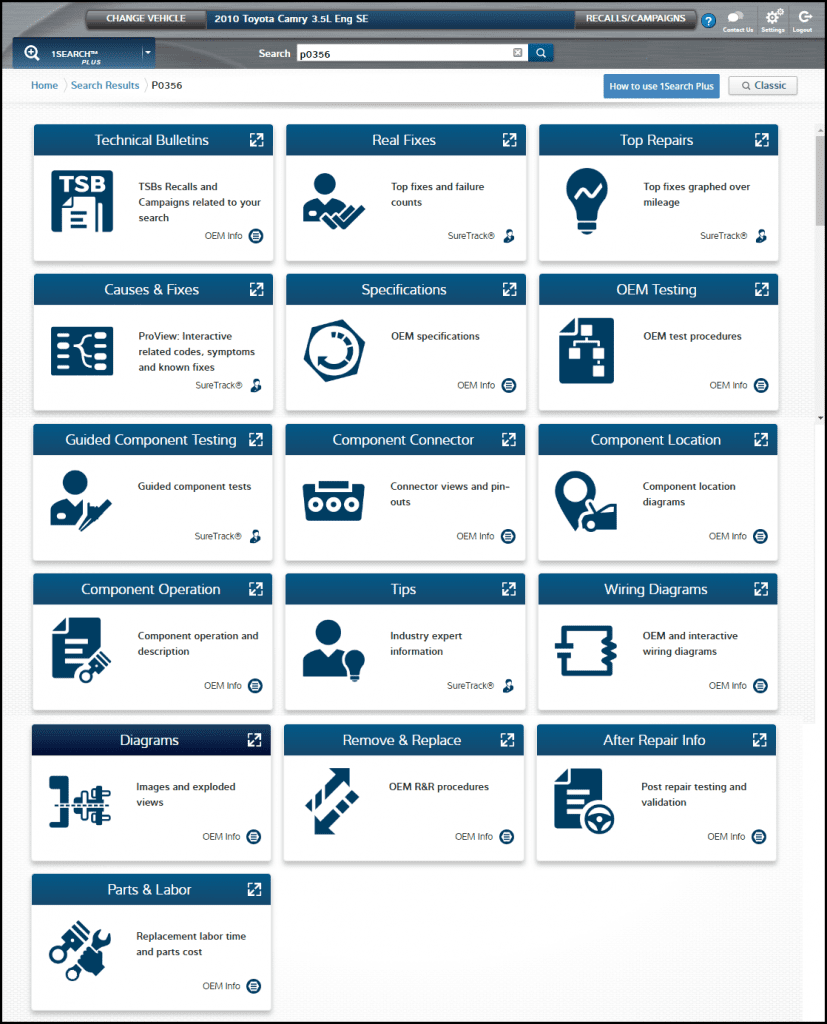Mitchell 1: 100 Years of Accelerating Data Delivery for Auto Repair

Mitchell 1 provides premium automotive repair software for professional auto care shops. This year, the company is celebrating its 100-year anniversary of providing information solutions that simplify everyday tasks for automotive professionals.
I had an opportunity recently to meet with Jeff Grier, senior director, Product Development for Mitchell 1, and Ben Johnson, director of Product Management, to get a briefing on how they are responding to trends in the automotive industry—with some help from MarkLogic®.
Delivering Information to the Point of Use
Q: Mitchell 1 has been around for 100 years now … how have the company and its products evolved over that century—what’s changed in the world of automotive repair information?
Ben: As you can imagine, there have been huge changes in the world of automotive repair information! As you know, we serve the automotive repair industry. Our customers are the shops you take your car into when it needs service. Those customers rely on Mitchell 1 repair information to help them maintain, diagnose and repair those vehicles.
One hundred years ago those vehicles were pretty simple compared to today. The wiring diagram for the entire vehicle’s electrical system fit on one sheet of paper. Fuel, ignition and the mechanical systems on the vehicle were pretty straightforward. Our manual back then, which covered most makes sold in the US, was probably a couple inches thick. The technology curve from then until about 1974 stayed on a slow and predictable path.
From the mid ’70s until now, however, there has been an explosion of technology that has reduced the emissions output of these vehicles to nearly zero and has increased fuel economy by hundreds of percent, all while delivering better performance and a host of features unimaginable just a decade ago—much less a century. With those new technologies come new challenges for the folks who have to service them, and that’s where Mitchell 1 comes in. To attempt to print a manual covering all vehicles sold in the US today would require a library instead of that two-inch manual. So we have evolved from delivering information on paper manuals to CD-ROM presentations on a PC, to delivery via the cloud and a web browser.
Q: So, if you’re delivering from the cloud, is the primary user accessing it from a web browser on a PC?
Ben: Yes, our information is primarily accessed from a desktop or laptop PC. However, we are “mobile friendly” and see increasing numbers of shops and technicians accessing our information on mobile devices. The goal is to support delivery to whatever device our shops find useful. Everything we do is focused on making the technician and the shop more efficient. Time is literally money for these folks.
How Mitchell 1 Meets Customers’ Needs
Q: Let’s talk about your customers a bit more. Mitchell 1 has been around for 100 years now. As you’ve evolved from paper to cloud delivery, what have you seen in terms of features your customers are most enthusiastic about?
Ben: As I mentioned, vehicle technology has literally grown exponentially over the past 40 years or so, and it’s showing no signs of slowing down. The average car today is much more than a mode of transportation. It runs more computer code than a fighter jet. They provide a growing list of features that keep people safer, connected and more productive while making their journeys.
The information required to properly service, diagnose and repair these vehicles has grown proportionally. But the volume of information creates more challenges. No longer can each part on a car be classified by a “category” like “suspension” or “electrical.” In a networked environment, a wheel speed sensor feeds information that is used to provide speedometer readings, anti-lock brake actuation, adaptive cruise control regulation, traction control functions and more. So what “category” does it belong in? How do technicians understand the components related to these systems and how to diagnose them when problems occur?
In addition to that, for any given component or diagnostic trouble code being researched, there are many “information types” available depending on why you’re researching. Wiring diagrams, removal and installation procedures, diagnostic procedures, component locations, what mileage a component breaks at—these are only a few of the available information types information products have available. And since we have not yet developed “telepathy,” we don’t fully understand why a shop technician is in the product—whether they only want to know how to adjust or replace something, or if they’re diagnosing a problem.

Our answer to all this is a feature we call “1Search Plus.” It is a complete departure from legacy information systems. A code, symptom or component can be researched and we present, in a cool “card” format, all the information types available. Literally, anything they want to know about a component, code, etc. is one click away. And it’s been a huge success! It’s been very gratifying.
Q: Very cool. So, how is MarkLogic helping you with this?
Jeff: It helps us deliver very focused information to our customers, very quickly. As Ben mentioned, there is a tremendous amount of information published for every vehicle on the road, both from the manufacturers and that we generate ourselves. As we load that content into MarkLogic, we break it up into paragraph-sized pieces and attach quite a bit of metadata describing what’s in the paragraph and what vehicles it applies to. We use MarkLogic to leverage that metadata to micro-publish and deliver only the content that is germane to the terms the customer entered. We’re always striving to make ProDemand and 1Search+ the “fastest path to fixed.”
Mitchell 1’s Experience with MarkLogic
Q: You’ve been using MarkLogic for a while now—I remember seeing a press release from back in 2011. How has your usage of MarkLogic changed over the years?
Jeff: We’re continuing to drive improved use of semantics into our products. There are considerable differences in terminology across the various manufacturers, let alone the proprietary content that we develop in-house, and of course, none of those match the term that our customers enter as a search term. We’re also evolving from searching on pretty concrete terms like “water pumps” and “exhaust systems” to much more abstract terms such as “adaptive cruise control” or even “sport settings,” which can add a lot of ambiguity to a search. Semantics is helping us bridge the gaps in that area.
Q: What do you wish you knew when you started using MarkLogic? Any advice for people who might be just starting themselves?
Jeff: I wish I had spent more time really understanding the fundamental differences between relational data stores and NoSQL schema-less data stores. We saw a pretty cool tool when we looked at MarkLogic back around 2010 or 2011, but I was new to the position and didn’t really understand the true power of that technology. I think it’s just now that we’re really at a point where we’re seriously exploiting all the goodies that are in there.
Q: What’s your favorite “goodie”? What are the next things in MarkLogic you’re going to be playing around with?
Jeff: We’re taking a very hard look at geospatial search and ways to apply that to deliver what we call “customer delighters”—features that provide us with distinct competitive advantages. There are some enabling technologies in that area that I believe we’ll be able to put to good use.
Responding to Emerging Trends
Q: Can you talk about what new things you plan to roll out for your customers?
Ben: Well, we ca’’t talk about future product features before they’re released. However, our industry continues to evolve and we’re evolving with it. There are an increasing number of sensors, radars, lasers and cameras that support advanced driver-assistance systems like lane departure warnings, blind-spot monitoring, adaptive cruise control and other features. All these features begin to enable the promise of the truly self-driving car. Our continuing mission is to make sure we have the necessary information to maintain, diagnose and repair these systems (and the systems yet to come) and present that information in intuitive ways that help drive efficiency to the shops that use our products.
We see communication between the vehicle, the vehicle’s shop and of course, the vehicle’s owner becoming more seamless. In fact, today we offer the only shop management system (we haven’t talked much about that, but this is the system a shop uses for scheduling appointments, ordering parts, invoicing the customer, tracking shop productivity, etc.) that can actually receive communications from vehicles equipped with certain connected car devices. And without giving away any more than that, those are areas we’ll be involved with.
I can tell you that at the Automotive Aftermarket Expo (AAPEX) in Las Vegas the end of October, we’ll be unveiling new features and products, and I’d invite anyone interested to look for those press releases or come visit us at booth 438!
For More Information
- To hear more from Jeff and Ben, attend the webinar on October 17, Mitchell 1 Celebrates a Century of Success in Connecting Customers and Data.
- Visit the Mitchell 1 customer case study page.

Alicia Saia
As Senior Director, Solutions Marketing at MarkLogic, Alicia is responsible for market messaging and content development for solutions across MarkLogic's verticals (Public Sector, Healthcare, Media, Financial Services, Retail, Energy, Insurance, etc.). Prior to joining MarkLogic, she held a variety of marketing and product management roles at software companies in the public sector, security, and healthcare markets.
Comments
Topics
- Application Development
- Mobility
- Digital Experience
- Company and Community
- Data Platform
- Security and Compliance
- Infrastructure Management
Sitefinity Training and Certification Now Available.
Let our experts teach you how to use Sitefinity's best-in-class features to deliver compelling digital experiences.
Learn MoreMore From Progress
Latest Stories
in Your Inbox
Subscribe to get all the news, info and tutorials you need to build better business apps and sites
Progress collects the Personal Information set out in our Privacy Policy and the Supplemental Privacy notice for residents of California and other US States and uses it for the purposes stated in that policy.
You can also ask us not to share your Personal Information to third parties here: Do Not Sell or Share My Info
We see that you have already chosen to receive marketing materials from us. If you wish to change this at any time you may do so by clicking here.
Thank you for your continued interest in Progress. Based on either your previous activity on our websites or our ongoing relationship, we will keep you updated on our products, solutions, services, company news and events. If you decide that you want to be removed from our mailing lists at any time, you can change your contact preferences by clicking here.


